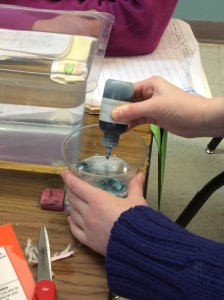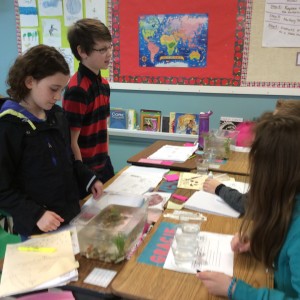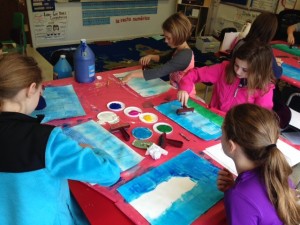Language Arts
This week we worked on:
- Community circle and sharing time
- New spelling list, palabras con j y g
- Writing: Writing a Summary
- Writing assessment: Writing a Summary (two sessions)
- Spelling sentences
- Independent reading time
- Saint Patrick’s day procedural writing fun: How to Construct a Leprechaun’s Trap
- Hands-on project: Building Leprechaun’s Trap
- Guest speaker: Ale visiting from Mexico (ask your child to tell you more about our wonderful visitor with whom they were able to use their Spanish in the most authentic way yet!)
 Science
Science
Continuing with our investigation 4, Aquatics Environments, we dove deeper into finding the effect that carbon dioxide produces in the water and fish. We discussed how living organisms affect the quality of aquatic environments. This week’s investigation consisted of finding the acidity levels of the water in our aquariums by putting a couple drops of BTB or Bromothymol blue (innocuous chemical to test water). They took samples of clean water, and water containing different organisms. After putting BTB in the water, students observed how the water changed colors, depending on the acidity levels: blue: no acidity, green:little acidity, yellow: significant acidity. After taking some other samples and blowing air though a straw into a cup (ask your child!) we concluded: both fish and humans exhale a gas called carbon dioxide (CO2). The carbon dioxide combines with water to form carbonic acid. Goldfish  cannot tolerate high levels of carbon dioxide for long periods of time.
cannot tolerate high levels of carbon dioxide for long periods of time.
One of our science objectives during our investigation:
- Students will be able to use the scientific thinking process to conduct investigations and build explanations: observing, communicating, comparing, organizing, relating, documenting, classifying and categorizing.
Math
We finished our chapter on pre-algebra this week and took a final chapter test to show our mastery. This was a fun chapter for myself and I believe the students enjoyed it as well. It was a rare time that we did things whole group during math. I had a good time interacting with the whole class at once on these various concepts. The students all took to it with rigor! Next week we will start discussing the area of triangles. At the end of this week your student should be able to:
-exhibit mastery in pre-algebra in writing, simplifying, evaluating and comparing the values of algebraic expressions as well as solving equations.
History & Geography
This week we did various map activities in and around the activities of the historical Westward Expansion of our country. We also took a deeper look into the importance of Daniel Boone. Next week we will pick apart some other integral historical figures of this time that we’ve only just briefly read about thus far in the unit. At the end of this week your student should be able to:
– read and interpret a map featuring the westward expansion of the United States
– read and interpret a U.S. Map featuring cattle drive and railroad routes
– interpret a U.S. map featuring rivers, mountains, and other important physical features
– read and interpret a U.S. map featuring the route of the Lewis and Clark expedition
– read a map featuring rivers, mountains, and other important physical features of the United States
– explain why Daniel Boone was important the the settling of the west
– state five facts about Daniel Boone
– describe the route discovered by Daniel Boone and explain its importance to westward expansion in an oral discussion as well as tracing it
 Art
Art
In 4th/5th grade art, we started a landscape project to go along with their westward expansion social studies unit. We spent the entire time making lots of “painted paper” using tempera paint and printmaking rollers. The students had fun experimenting with various colors and textures! Next week they’ll use these painted papers to create a landscape collage.
Music
We celebrated St. Patrick with Sr. Kit’s Peruvian harp, on which he played a variety of traditional Celtic as well as Latin American pieces. We also talked about Andean harp traditions stretching from Chile to Venezuela.
